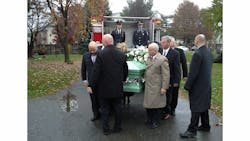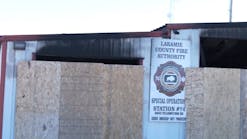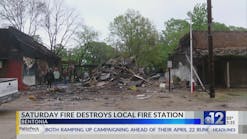Dr. John Bryan Remembered as FPE Pioneer
Source Firehouse.com News
FREDERICK, Md. -- They came from across the country. Some were firefighters, some fire marshals, others in private firms and many have their handprints on fire codes and laws.
Regardless of where they ended up, all shared a similar beginning as graduates of Fire Protection Engineering program at the University of Maryland.
Earlier this week, they remembered their mentor and friend, Dr. John Bryan, fondly known as “Prof.”
Bryan, often referred to as a fire protection pioneer, died Oct. 13. He was 89.
“John Bryan was the right person with the right vision at the right time and the right place,” recalled Dr. James A. Milke, current chair of the UM Department of Fire Protection Engineering.
Milke explained how Bryan developed and promoted the program, long advocated by the Maryland State Firemen’s Association.
The meeting that would solidify the engineering program was held Jan. 30, 1956 with Gov. J. Millard Tawes, the day after the horrific Arundel Park fire claimed the lives of 11 people.
Although the momentum for establishing the program had been mounting, that event proved to be the catalyst.
“While the state provided financial support for the program, everyone at the university did not embrace this new department. So, in the initial years John Bryan ‘Prof’ had to ward off frequent attacks on the department and the resources provided to it,” Milke added.
Students who showed up at his office inquiring about the program quickly learned Bryan wasn’t just going to be their professor. He was going to be their mentor and father figure. And, he gave pushes when one was needed.
If he thought they’d make it through the program, he pulled out all the stops to make sure they did. He cut red tape many a time not only to get his FPE students into courses, but the university itself.
David Hammerman, one of four who graduated in the first class in 1962, said he really can’t find the appropriate words to describe what Bryan did for him.
He was involved in civil and electrical engineering when Uncle Sam came calling. Two years later, he returned to the university with no real direction.
“I didn’t know anything about the fire service or being a firefighter. So, I didn’t really know right away what a fire protection engineer would do,” he said with a laugh.
“I don’t remember how I found out. Maybe it was a sign or a flyer…” But, after a brief meeting with Bryan, his decision was made – FPE it would be.
Hammerman, the first fire protection engineer hired by the Maryland Fire Marshal’s Office, credits Bryan for his tenure in the field as well as being named a Fellow.
“It’s quite amazing how the whole thing wound up,” he said, adding that he’s still involved as a building and fire code consultant.
Research also intrigued Bryan, and he conducted a study about human behavior, and its role in the deadly Arundel Park fire. Years later, obtained a grant to further the work, publishing “Human Behavior: A Critical Variable in Fire Detection Systems.”
Bryan was proud of his graduates, and said they also should be easily identified as such. They were expected to wear big yellow buttons at special events. It was a no-no to forget, they said.
On Monday, more than 150 buttons were visible on jackets, dresses and sport coats.
FDNY Battalion Chief Joe Jardin said he was amazed at Bryan’s memory over the years.
“He remembered your name, your spouse’s name and where you worked. And, he made a point to invite you to dinner if he was speaking in your city…”
Jardin said Bryan knew he and others in his program wouldn’t give up fighting fires, and he was OK with that. “We were never treated differently. He was our mentor and friend…”
Bryan also was a firefighter, and is credited with establishing The Rinky Dink Fire Department in the mid to late ‘30s in Montgomery County, Md.
He and several other boys made it their job to extinguish brush fires often sparked by coal falling off the steam engines. Read more from Bethesda Fire Department.
Bryan went on to become a volunteer with College Park Volunteer Fire Department, located directly across from the UM campus. A life member, he still attended annual functions until recently.
Many FPE students live at the firehouse while attending college.
Mark Salley told fellow graduates about his five hour drive from his home in Pennsylvania to check out the fire engineering course he’d heard about.
“I was hoping to get on Dr. Bryan’s calendar so we could talk about it,” he said.
Minutes after walking into his office and talking to a receptionist, he was taken back by her response: “He’s in right now. Go on in…”
Salley added that his future mentor made him feel at ease asking about his t-shirt and the type of fire trucks his department had.
Bryan openly welcomed women into the program as well.
“Prof made me feel welcome within 15 minutes where I never felt welcome in aerospace after almost two semesters. I had been looking for a home and found it with fire protection. I wanted to be part of a profession that affected the greater good and could possibly make a difference in many people’s lives. It was the one conversation, one decision, that changed my life forever and took me down a path I would not have taken otherwise,” Deidre Willard said.
She added: “He challenged you, made you do better than you would have done otherwise and truly cared. He might give you a snowman every now and then, letting you know he knew you were trying to “snow” him, but he always wanted everyone to do their best and be successful…”
In honor of his late wife, Sarah, Bryan established a scholarship for women who want to take the FPE courses.
D.C. Firefighter Danny Troxell said graduating didn’t mean your relationship with Bryan was over.
“He was unique. He kept up with where everyone was and what they were doing. I don’t know how he remembered all that…”
Stacy N. Welch, senior director of Fire Protection and Life Safety for Marriott, said Bryan always made her feel accepted.
“There was always a feeling of welcome. He set the example for the department…”
In addition to teaching the FPE courses in Maryland, he traveled to lecture on behalf of the Fire Marshals Association of North America.
Bryan wrote in one of his studies: “…The human behavior of the individual is the most important variable in the effectiveness of a fire detection system…Fire detection devices or systems designed for the protection of human life can only be considered effective when an appropriate human behavioral response is ensured…”
While he established a fire department as a boy, a fire protection engineering department at a university, and received international honors, Bryan will be remembered for his genuine love of his students.
“He infused the sense of caring into the group of people who entered through the doors of that department. That’s his legacy,” Milke said.






